

For any business, be it a small organisation or a multinational corporation, succession planning is an essential aspect of the success of an organisation.
It’s all about identifying and developing potential leaders from among the current employees, thus ensuring that the right people are in place to take over when key individuals depart, whether that’s due to retirement, resignation, or unforeseen circumstances.
While succession planning may seem daunting, it’s also an opportunity to identify and develop new leaders, build a stronger team, and set your organisation up for long-term success.
This blog will look at the definition, importance, benefits, process, and best practices for succession planning.
Let’s dive right in!

There is a subtle, yet significant difference between training and development.
To develop your sales team, you need to train them first.
Throughout this blog, I shall aim to make it easier for you to recognize the difference between Training and Development by discussing the points mentioned in more detail.
So let’s dive in and better understand the critical difference between Training and Development.
Training programs help employees understand the company’s job performance and rules and regulations. Companies and organisations develop their training program to train recruits selected and recruited by the company.
Training programs inform them of company rules, regulations, policies, and processes. On-the-job, induction, apprenticeship, and promotion training programs are critical in organisations.
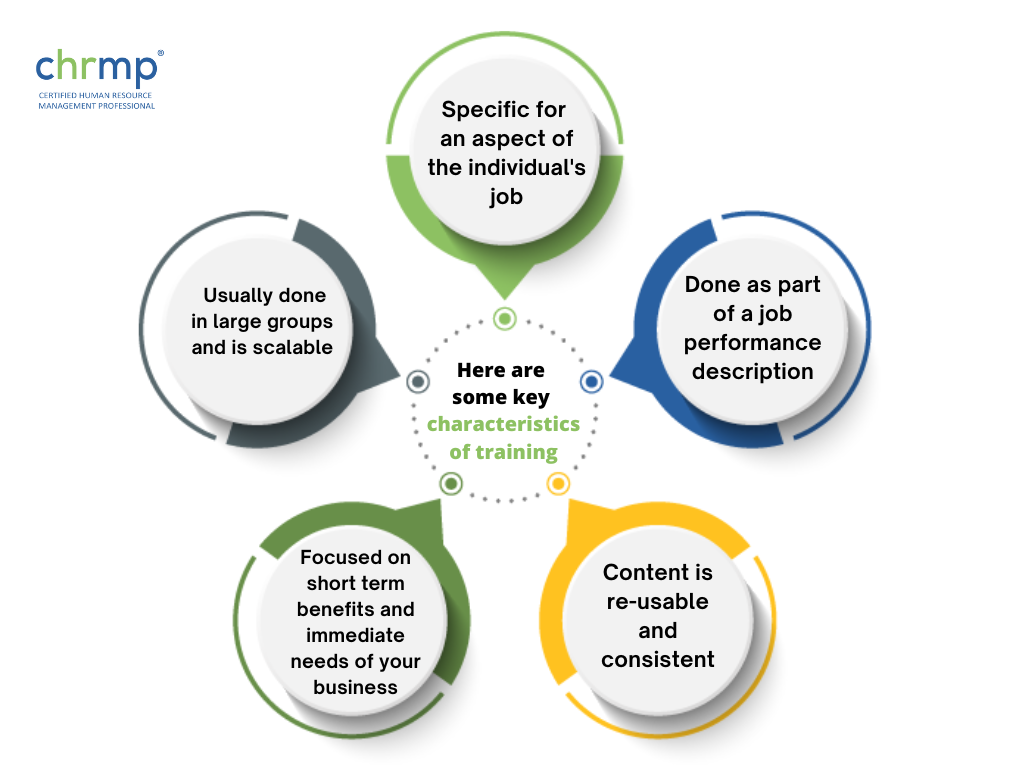
Training is the action of teaching new things. The objective is to teach the employees new skills through a structured learning experience that requires passive engagement from the learners and is focused on short-term benefits and the immediate needs of your business. Training is usually done in large groups and is scalable (up to hundreds or even thousands of people at once).
The training aims specifically to an aspect of the individual employee’s job, and the content is reusable and consistent. You can measure the employees’ understanding of the training. An experienced trainer usually gives a teacher-training course.
This type of training is often done as part of a job performance description. The progression is linear, meaning that once you’ve mastered one skill level, you’ll move on to the next. Learning and Development (L&D) specialists help companies improve employee performance by providing training and development opportunities.
These professionals work closely with managers and human resources departments to design and implement learning plans. They also conduct assessments and evaluations to determine if employees need additional training or coaching.
Development programs help companies to develop their employees’ abilities. These programs are designed to make employees better and more robust, allowing them to be ready to face new challenges.
Development refers to development activities conducted in an organisation or a business. This training is also known as executive development or management training. This process of development activities aims to improve the employees’ conceptual and intellectual knowledge. Employers also aim to boost workers’ efficiency and effective functioning at work.
Another significant difference between training and development is that unlike training, development is a more holistic process of boosting the overall growth of individuals. It helps to develop individual personalities on the whole. By altering and shaping the employees’ approaches and making them more competitive, trainers assist them in becoming better people.
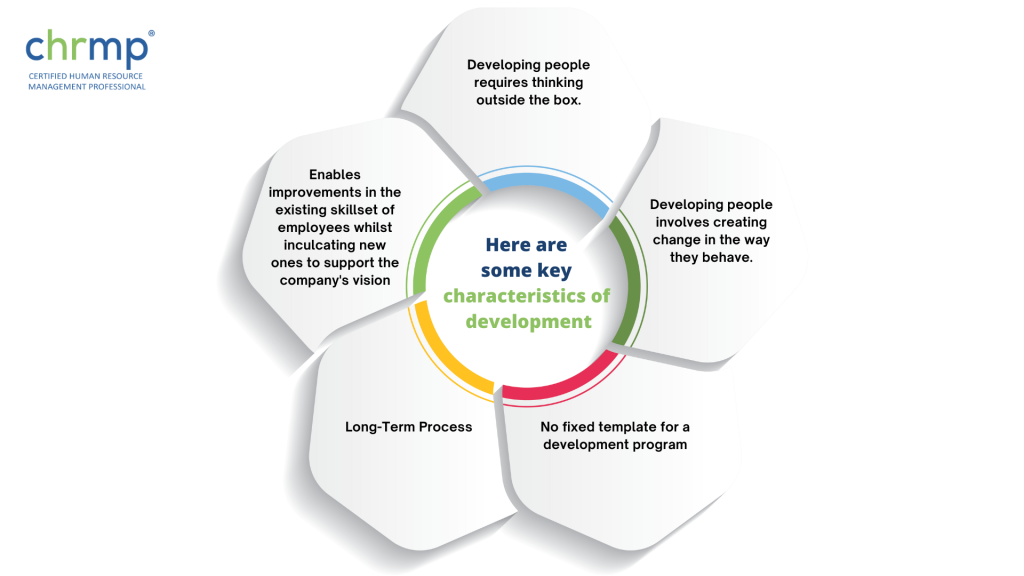
Development is a process that enables improvements in the existing skillset of employees, whilst inculcating new ones that support the company’s goal. The first step to employee development is to figure out what problem you want to solve. Next, you should decide whether to build a product or service. Finally, it would be best if you determined which technology you want to use.
A development plan is a Long-Term Process. One of the examples of development training is personal development in a person’s lifetime. Developing people involves creating change in the way they behave. You have to find ways to get people to act differently than they did before. That’s why developing people requires thinking outside the box.
You will probably need to involve others during the process of developing people. For example, you may need to consult with other experts or colleagues.
You might also consider using different methods to develop people. Some people prefer to learn by reading books or watching videos. Others like to practice skills in real-life situations.
We have spoken about the difference between Training and Development. Now let’s view the similarities in the characteristics of Training and Development.
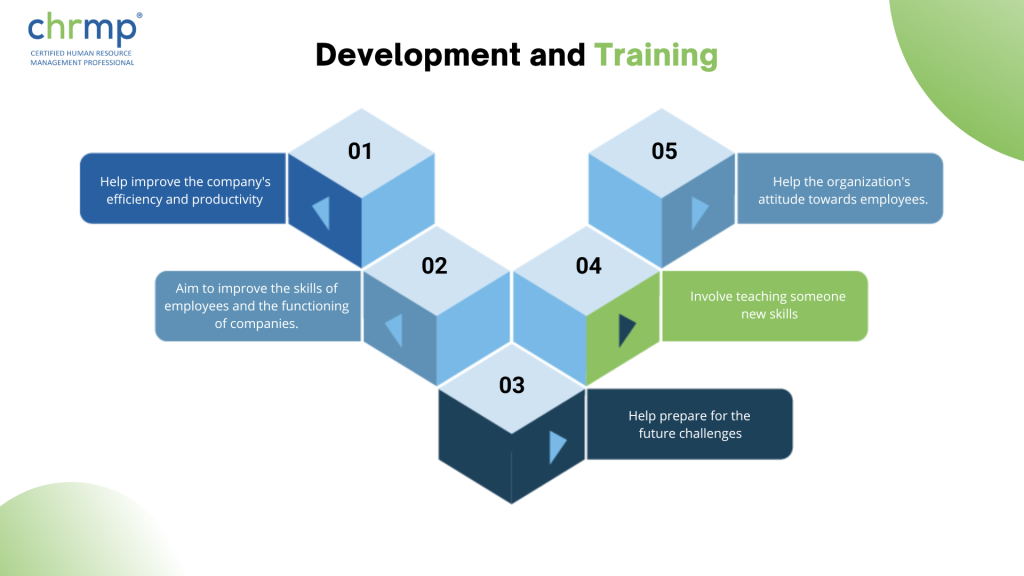
Training and Development Program help improve the company’s efficiency and productivity, an applicable job requirement. Training and Development Program also help the organisation’s attitude towards employees.
Training and development programs aim to improve employees’ skills and companies’ functioning. Organisational heads try to create an attitude change in their employees.
Training and development both involve teaching someone new skills. However, they differ in that training focuses on one skill at a time whereas development focuses on multiple skills simultaneously.
One of the significant similarities between training and development is that they both help prepare for future challenges.
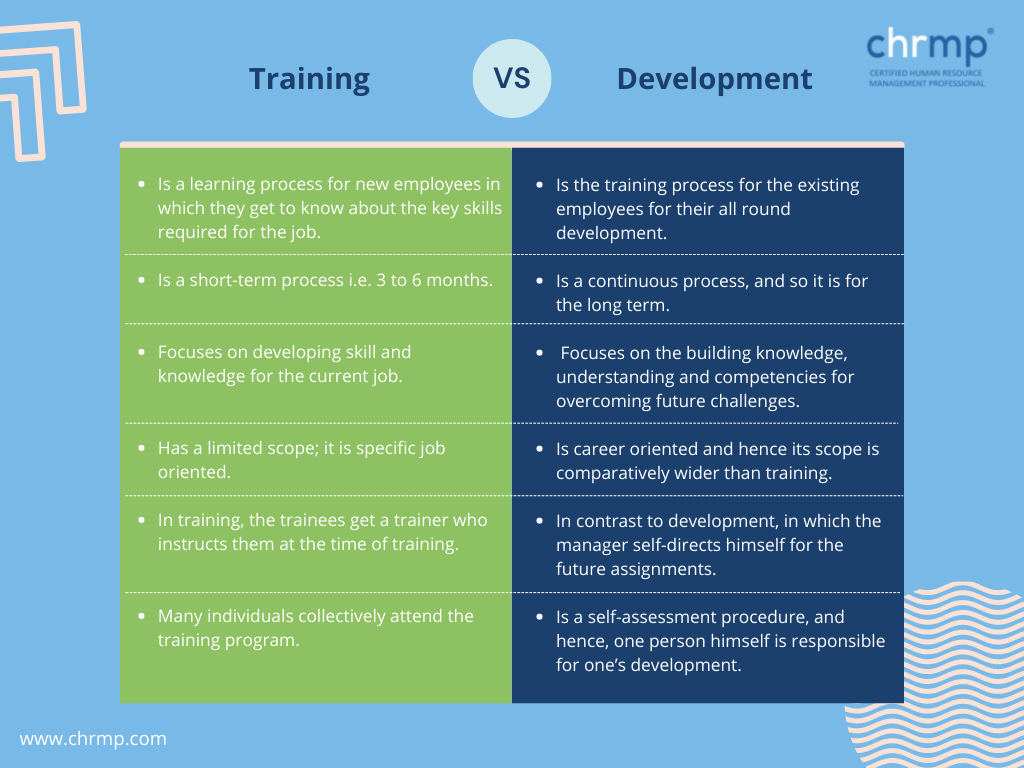
The main difference between training and development is that development is a continuous process while training is a one-time event. In addition, the development focus is on the learning process and improving personality traits.
If we compare the terms “training” and “development”, we can see many similarities between these two concepts. Both these processes are aimed at enhancing the performance of employees.
However, a specific difference between training and development is discussed below.
Training & Development: A training program is designed to improve the employee’s skills. On the other hand, a developmental program aims to develop the employee’s personality.
The focus of training program is usually conducted once a year. In contrast, a developmental program is carried out continuously throughout the year.
In a training program, the trainer teaches the employee all the necessary skills required for his job. But in a developmental program, the trainer helps the employee better understand himself.
In the process of training, the emphasis is on acquiring knowledge. In a developmental program, it is more critical to develop behavioural skills.
A training program has a limited scope. It is focused on specific tasks and duties. The trainers teach the employees how to perform those tasks effectively.
On the other hand, a development program is extensive. It covers various aspects of human behaviour. Thus, it helps the employee become aware of his own strengths and weaknesses.
Experts usually conduct training programs. In comparison, developmental programs are led by psychologists specialising in this field.
A training program lasts for a short time. Whereas a developmental plan may last for years or even decades.
A training program provides immediate feedback. Whereas a developmental process does not provide any feedback.
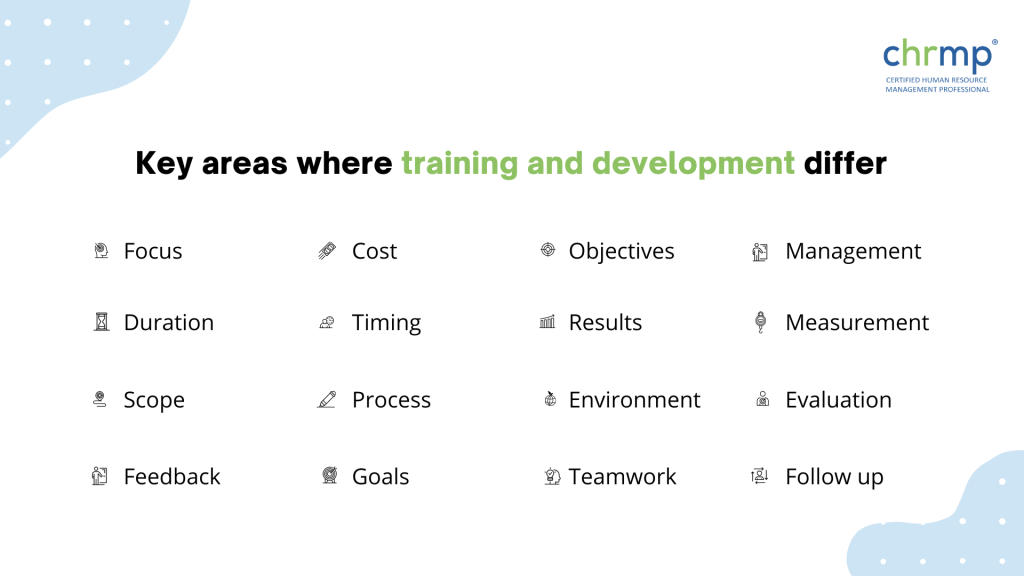
The difference between training and development is discussed in greater detail below:
1) Focus
Both training and development have similar goals. They aim to enhance the performance of an individual. However, the focus of development lies in developing personality traits.
2) Duration
Another key difference between training and development is the duration of each process. Training programs are usually conducted once a month. At the same time, developmental programs can be run daily.
3) Scope
Training programs cover only a few areas of life. For example, they help you learn how to use a computer or write a report.
Developmental programs cover almost every aspect of your life. For example, it will help you to manage your money, handle relationships, etc.
4) Feedback

Training programs do not offer any feedback. In contrast, developmental programs provide continuous feedback. This feedback enables the employee to modify their actions accordingly.
5) Cost
The cost factor is a major difference between training and development. Development costs less than training. You need to spend less time and effort conducting a developmental program.
6) Timing (Duration)
Training programs are conducted yearly, whereas developmental programs can be done anytime.
7) Process
Training programs are conducted in a formal manner. At the same time, developmental programs take place informally.
8) Goals
The goal of training is to improve the performance of an individual through practice. On the other hand, the purpose of development is to change an individual’s thinking.
9) Objectives (Goals)
There is a stark difference between training and development with regards to the objective. The objectives of a training program are clear-cut. For example, you want to increase your salary.
On the other hand, the objectives of development are vague. For example, you might want to develop yourself.
10) Results :
Results of training are measured objectively. For example, you get a certificate if you complete a training course.
However, the results of development cannot be measured directly. For example, you cannot measure the effect of a developmental program on your personality.
11) Environment
Environment is also a key factor in the difference between training and development. In a training environment, there is no distraction. There is also no pressure from colleagues.
Whereas in a developmental work environment, there are always a lot of distractions. Moreover, you feel pressured to perform better.
12) Teamwork

Team members work together during training sessions. Whereas team members often compete with each other during development sessions.
13) Management
Management plays a significant role in both training and development. During training, management helps you understand the training session’s objectives. Whereas, during development, management allows you to identify the problems you face in your job.
14) Measurement
During training, measurement is done using quizzes. Whereas, during development, measurement is done by observing changes in behaviour.
15) Evaluation
Evaluation is done after completion of training. Whereas in development, evaluation takes place before starting a new project.
16) Follow Up
Follow-ups are conducted after the completion of training. The purpose is to ensure the trainee has learned what they should know.
On the other hand, follow-ups are conducted before starting a new project to ensure that the trainees have understood the instructions properly.
There are several aspects of difference between training and development. Training and development are two different programs used by Human Resource Management. There are differences between them, including objectives, number of people, orientation, focus, terms, and motivation.
Learning and training are two different processes. Both play an essential role in the development and performance of employees. By understanding the key differences of each cycle, you can design learning and training objectives and strategies that help you achieve your long-term goals and build your company’s future vision.
Training helps people learn new skills and improvise their basic skills. The learning process helps people grow as individuals. Both are important to your company. It would be best if you used both to develop your employees.
A: Training focuses on acquiring or improving specific skills or knowledge related to an employee’s current job, while development is broader and more long-term, encompassing personal growth, career advancement, and overall professional enrichment. Training is usually job-specific and focuses on immediate performance improvement, while development aims to prepare employees for future roles and build their capabilities beyond their current job responsibilities.
A: Training is primarily aimed at improving job-related skills, knowledge, and performance, while development focuses on broader aspects such as career growth, leadership development, and personal enrichment. Training helps employees acquire or enhance the skills needed to perform their current job effectively, while development focuses on preparing employees for future roles and fostering continuous learning and growth mindset.
A: Examples of training initiatives may include job-specific skills training, technical training, compliance training, and safety training. These initiatives are designed to address immediate job-related needs and improve performance. On the other hand, examples of development initiatives may include leadership development programs, mentoring programs, career planning, and professional certifications. These initiatives are aimed at building employees’ capabilities for future roles and broader career growth.
A: Training is typically short-term and focused on immediate job-related needs, while development is long-term and encompasses a broader perspective. Training can be completed within a relatively short timeframe, whereas development is an ongoing process throughout an employee’s career. Training is often specific to the current job role, while development focuses on broader skills, knowledge, and abilities that can be applied to various roles and responsibilities in the future.
Training and development are key processes in human resource management. Training focuses on teaching specific skills or knowledge to improve immediate job performance, while development emphasizes long-term growth, preparing employees for future responsibilities. For example, a training program might teach employees how to use new project management software. In contrast, a development program might include leadership coaching to enhance strategic thinking and decision-making abilities. Together, training and development aim to build a skilled, adaptable workforce that meets both current and future organizational needs. These processes ensure continuous improvement and alignment with business goals.
HRM (Human Resource Management) focuses on managing the workforce, covering activities like recruitment, payroll, compliance, and performance management. It is operational, addressing the immediate needs of the organization. HRD (Human Resource Development), on the other hand, emphasizes employee growth and long-term capability building through training, development, and succession planning. For example, HRM involves hiring new employees and managing their benefits, while HRD focuses on mentoring those employees for future leadership roles. HRM is task-oriented and transactional, while HRD is strategic and transformational, aiming to foster a culture of learning and innovation within the organization.
Training is the process of enhancing employees’ skills, knowledge, and competencies for improved job performance. It addresses immediate business needs and ensures that employees are well-equipped for their roles. Types of training include:
I hope I was able to explain the difference between training and development. If there is anything else, you would like me to add, please feel free to ask through the comment section below.
You may also leave suggestions for what you would like me to write an article about next. I aim to answer as many HR-related questions as possible through my blogs and articles.
Thank you very much for taking the time to read this blog. Have a nice day!
© 2007-2025 CHRMP| All Rights Reserved | Powered by Ripples Learning & Research Private Limited
